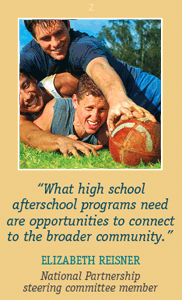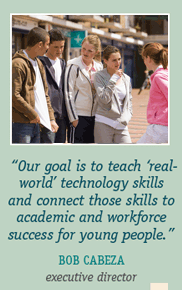 |
|
 |
 |
|
||||
 |
Afterschool Choices for High School Students As students get older, their participation in afterschool programs often declines. They have more choices for how to spend free time and the freedom and mobility to pursue other activities. However, research shows that high school students who participate in afterschool programs improve their grades and school attendance, and are more likely to graduate on time.1 Below are some ideas on what high school students are looking for in an afterschool program. Community involvement. “What high school afterschool programs need to keep students interested are opportunities to connect to the broader community,” says Elizabeth Reisner, a member of the National Partnership for Quality Afterschool Learning steering committee and co-founder of Policy Studies Associates, Inc., an education research organization. Students can interact with the community through service activities like volunteering at a hospital or through service learning, which incorporates academic curriculum into the community activity. Career and college preparation. You can help students plan for their futures by arranging for students to spend time “shadowing” someone who works in a field that interests them. They can visit a local community college or university to talk to students and faculty and learn about classes that might interest them. “Job shadowing and college visits are also excellent ways to promote community involvement,” says Reisner. Opportunities to help shape afterschool programs. Students can influence what an afterschool program offers in a variety of ways. Some high school afterschool program directors have collected surveys from students and then used the feedback to decide what activities to offer. Even if your program has clear academic goals, activities can still be created around student interests. For example, if your program’s goal is to improve student literacy, you can let students decide whether they want to organize a book group, perform a play, or publish a book of student interviews with community members. You can find these literacy activities for high school students in the online Afterschool Training Toolkit. 1 Friedman, L., & Bleiberg, M. (2007). Meeting the high school challenge: Making after-school work for older students. New York: The After-School Corporation. |
|

YMCA Youth Institute
|
|
|
||||||
|
||||||
 |
|
|
Questions or comments should be directed to: Laura Shankland |
Copyright © 2007 by SEDL. This newsletter was produced in whole or in part with funds from the U.S. Department of Education under contract number ED-01-CO-0057/0001. You are welcome to reproduce issues of AfterWords and distribute copies at no cost to recipients. Please credit SEDL as publisher. Link to PDF versions of AfterWords is available here. For additional uses, please fill out and submit a copyright request form. |





